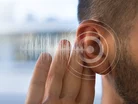Solving assistive listening challenges with medical devices

At all life stages, communication and good hearing health connect us to each other, our communities, and the world. Public hearing assistance is critical for people with hearing loss. Background noise is a real challenge. One benefit of an assistive listening system is that it helps curtail background noise, allowing individuals to better access the sound source they want to hear, whether it is a speaker at a convention or a person at a service counter.
While current assistive listening systems (ALS) have provided great benefits to people with hearing loss, several challenges have hindered their deployment, including limitations in function and performance, the cost of installation and maintenance, and a lack of secure and private communications.
Assistive listening and medical devices
For years, three types of assistive listening systems have been used to support people with hearing loss: FM, infrared, and hearing loop systems. Though the sound quality can be good, FM and infrared systems require individuals to borrow a receiver from the venue. It is impossible for a user to bring their own device and having to acquire a venue-specific device to gain audio accessibility can lead to feelings of stigmatisation.
The third option is a hearing loop. Hearing loops are one of the more commonly used solutions to support hearing loss in public venues and are the closest thing to a standard for assistive listening. Telecoils built into hearing devices allow users to access a hearing loop without needing a separate receiver. Unfortunately, not all hearing aids have telecoils, and hearing device wearers are not necessarily aware that they have a telecoil in their hearing devices. In some cases, a telecoil is available in the hearing device, but it has not been programmed for use.
Hearing device users who have built-in, programmed telecoils find they are easy to use. A simple button pushes or flip of a switch on the hearing device provides access to the audio signal. But loop systems have several limitations. One disadvantage for the consumer is that the signal is in mono, and there are times when you want to listen in stereo and unless the venue installed the hearing loop when the building was constructed, it’s extremely expensive to reconfigure the building for hearing loops.
Assistive listening healthcare technology
Industry experts anticipate Auracast™ broadcast audio will become the next-generation assistive listening system. There’s a good probability that this will eventually come to fruition, but complete market saturation could take years, maybe even decades, to realise. In the interim, its ability to function in tandem with existing assistive listening technologies will enhance accessibility for a wider range of people with hearing loss.
The low cost of installing Auracast™ broadcast audio will be a big benefit. In many regions, legislation has driven the deployment of an assistive listening system. If systems can be deployed at a lower cost, the benefits they provide visitors in public spaces will incentivize venues to install them.
Recently, the IFHOH published a declaration that states: “It is important to have both telecoil and Auracast™ technologies in hearing aids and cochlear implants until most users will feel they can rely on Auracast™ broadcast audio.” IFHOH recognised that one of the most important and impactful promises of Auracast™ broadcast audio is to assist hard-of-hearing individuals to hear better in venues where hearing aids and cochlear implants are insufficient to function. The IFHOH said it “foresees a world where FM, infrared, and hearing loop systems (including those found in taxis, ticket counters, airports, theatres, etc.) will function for the foreseeable future alongside Auracast™ systems.”
Medical devices going beyond assistive listening
Overcoming the challenges of traditional assistive listening technologies by using a familiar, proven technology ubiquitous in most consumer audio devices will provide the added benefits of enabling broader deployment and increasing the availability of assistive listening for people with hearing loss. It will also expand the applicability of this type of audio access to consumers with all levels of hearing health.
With Auracast broadcasts, there is an opportunity to create an assistive listening system that can benefit not only those with hearing loss but also those who can’t hear what is being presented. Auracast™ broadcast audio is not only beneficial to those using hearing aids, it is also beneficial to the general public.
Byline written by Chuck Sabin, Senior Director, Market Development at Bluetooth SIG
- UNEP: Tackling Climate Change to Decrease Health Issue LoadSustainability
- Vaccines, Dementia & Food: The Week's Top Healthcare StoriesMedical Devices & Pharma
- The Toxic, Food-Borne Chemicals Costing Healthcare TrillionsHospitals
- How Amgen Combines Life-Saving Biotech & SustainabilitySustainability



